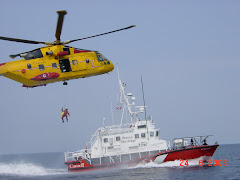Tracking is another story altogether. Typically I (and most, if not all SAR Techs) learn how to do things proficiently and much quicker than the vast majority of people. But tracking is one skill I can say without a doubt would require me to do for years to become confident and competent at. Some signs are obvious. ie. a footprint. But when you get down to it you're looking for stuff you would not normally notice. A bent piece of grass, a loose rock, even so far as something you think you see but when you look at it objectively there's nothing visibly abnormal. I found this to be challenging and frustrating and am thankful that SAR Techs don't normally have to resort to this tactic. The idea is that there is always a sign. It might be a bootprint that matches the description of your quarry (such as danners) or it might be some chlorophyll from grass on a twig or rock that was smeared by the weight of a passing person. There is usually a distinct heel print or toe kick which allows you to measure the distance of stride. You then use this length, dependent on the terrain to find and compare other signs. Personally I didn't find it to be easy or efficient and was glad it only lasted a week.
Final Ops started after a day "off" in Jarivs Lake. Which (of course) consisted of us working our sacks off trying to get the last few camp projects done, because as sure as shit we were not going to get any spare time once final ops started. This resulted in probably the best looking and by far largest set of pararescue wings to grace the confines of the Jarvis Lake training for years to come. Once Final Ops started it was business as usual. We started off by refreshing our jumping skills by doing some confined area jumps. This was awesome because we got to jump into some new confined areas, and at most we only jumped into an area twice which meant almost every area was a new area to analyze and adapt to. At some point two guys forgot kit back at the camp while in the meantime the skyvan was on approach to take us up for the first lift at the airfield. To be clear (and watch out for this 43) that kit HAD been mustered and WAS in place to get loaded on the trucks, BUT one the staff (Kevin) was suspected of removing some of the gear. This resulted in a (suspectedly fictitious) snap show by the Chief and phase NCO. After the days training was finished we were mustered and given 5 minutes to run to the boat shed and change into our dry suits with fins. We then had to swim approx. 1600m, that we wisely decided to swim as a group. Meaning we could go slower and blame was implicated on the slowest person, who was, in this case working his bag off to try and not be the slowest guy. However on the 1600m back we were told it was an individual effort and we had to go as hard as we could. Ball-drag. A not-so-subtle reminder that despite the fact that it's been a year, the course is not over. Anyway to not give too much away to upcoming courses, final ops is a great time complete with reminders that "it's not over yet". The ability to improvise is paramount and you can and will be expected to do any and everything you have learned on the duration of the course. Good times had by all.

